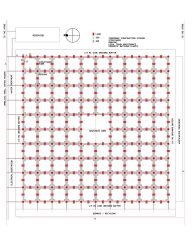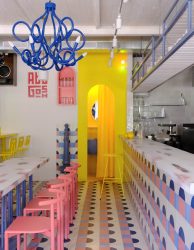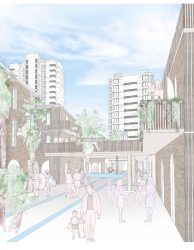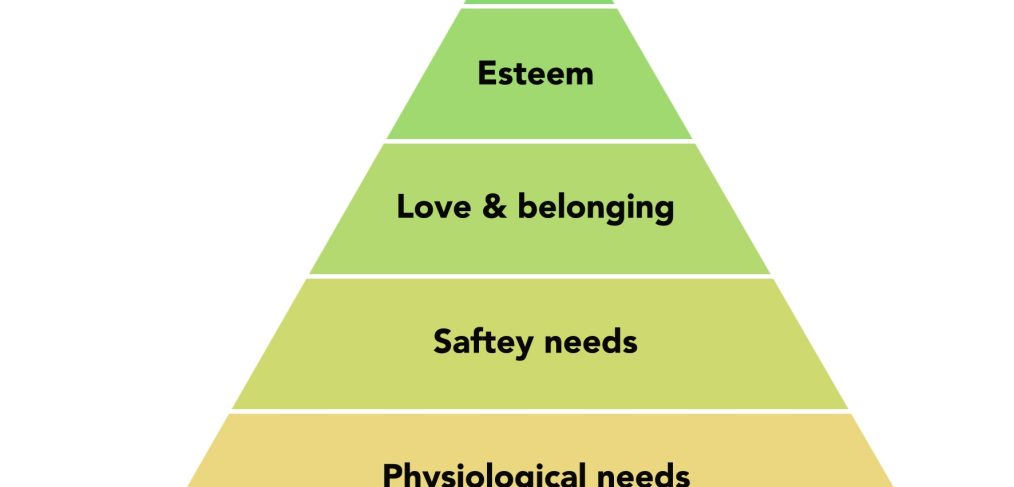
Architecture’s Hierarchy of Purposes.
Author name: Asma Alothman
Instagram account: @domestic_arch_kw
I’ve always been fascinated by Maslow’s hierarchy of human needs theory. How it implies that no matter how complex and diverse we individuals are, at the end, the same simple hierarchy of needs govern us all. Building up from the primitive Physiological Needs of air, food, and water, to the ultimate need of them all, Self-Actualization (Figure: 1). The theory also implies that the fulfillment of any need depends on fully or partially satisfying all the needs beneath it in the hierarchy. Thus, as much as we would like to see ourselves as unique and independent individuals, we are all joined together in the quest of fulfilling the same needs, one after the other.
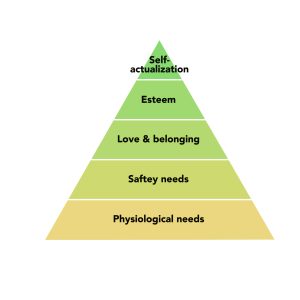
Figure (1): An interpretation of Maslow’s hierarchy of needs, represented as a pyramid with the more basic needs at the bottom.
Could architecture have a similar model of needs or a hierarchy of purposes to be achieved? If it could, what would be the levels of purposes for the model? What purposes should be grouped together at the same level? Are these needs interdependent, where fulfilling one purpose at a certain level requires satisfying all purposes in the levels below? And most importantly, what level or purpose should come before the other?
Let’s start from the bottom up. The first level would seem fairly obvious, since architecture has served as a form of shelter and sound structure from the early histories of humanity. Therefore, the primal purpose of Safe Shelter could be the base level of the pyramid model.
The second level might consist of two purposes Spatial Arrangement and Visual Appreciation. Spatial Arrangement, a functional objective, refers to the aim of establishing a strong -horizontal and vertical- relationship between spaces to achieve a building product that could successfully accommodate its objective, that being a house, place of worship, office building, or an airport. Visual Appreciation refers to the aesthetical objective, the aim of creating an eye-pleasing product, an icon for the city, a symbol or a message.
These two purposes have been located together at the same level due to the “Function Follows Form” verses “Form Follows Function” debate.
When the definition and purpose of architecture is limited to these first two levels, the result may possibly be an architecture that is bland and mute. Such a narrow definition might even lead to the presumption that a layman with some professional engineering assistance could produce a piece of structure and call it architecture. Why not? With some engineering assistance one could construct a sound Shelter. In terms of Spatial Arrangement, well, who better than the end users with their experience and knowledge of what they want and need know what works best to function well for their buildings? In addition to that, everybody is entitled to have an opinion on aesthetical matters; therefore Visual Appreciation could be achieved by mere anyone!
Unfortunately, it is this simple comprehension of architecture that leads to shallow results. Even some professionals that fulfill these two levels of purposes, ticking away the minimum requirements for a suitable habitable place, would end up with immature results. Honest architecture begins only when architects are willing to put in the extra time, effort and money to produce a functional work of art. This would make them successfully achieve the first two levels and the ones to come.
At the third level, the purpose of achieving an Inviting Milieu and Function are located. Inviting Milieu refers to the shift from architecture as being a “design to accommodate a job” towards a “design to attract and sustain social activities”. These two different approaches can yield two distinct results; while the first views places and objects in a superficial manner, the second would need sensitive consideration to elements such as comfort levels and social habits. Here, in an architect’s mind, a house’s main door is transformed from being just an entrance into a more profound meaning, such as the place were people first meet, or wait to be greeted, or the transitional area from public to private. Similarly, a bench is no longer thought of as just an object to sit on, but a place that should invite, or an opportunity for social interaction. Once this is imagined, sensitive considerations and detailed needs would emerge and require designed solutions other than what is considered in the first two levels of the hierarchy.
Function in the third level refers to the dialogue created between architecture and the diverse environments that interact with it. Since architecture is not isolated from elements such as climatic conditions, environmental issues, socio-cultural factors, and health concerns, the built environment should be designed as a reaction to these factors, hence function with them instead of against them.
A possible fourth and final level of purposes is the Perception and Stimulation of the Senses. This has been a design philosophy and an academic interest for several phenomenologist architects such as Peter Zumthor, and Juhani Pallasmaa, and is positioned on the model’s peak as the final or highest purpose of architecture. To achieve this level, an architect must relay on his or her relationship towards the natural and built environment, and realize that perception of architecture could be achieved using channels other than our dominant visual sense, which requires a great degree of sensitivity and awareness on the architect’s behalf. A basic example of how architecture connects to our senses is how we often use our muscular memory with our visual sense in navigating our way through a building. This is most evident in frequently used buildings such as our home or work place. The purpose of Perception and Stimulation of the Senses is mostly highlighted in religious architecture. Places of worship, used for concentration and meditation, aim at creating a long lasting impact on their visitors’ experience. Hence a design that stimulates our senses, tactile and visual alike is needed to reach this aim. When this is achieved, it would be here, at the final level of purposes, that a work of architecture is most memorable.
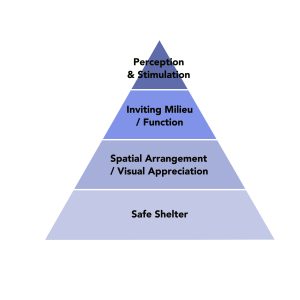
Figure (2): Architecture’s Hierarchy of Purposes Model, an adaptation of Maslow’s Hierarchy of needs.
Returning to our earlier question, can architecture have its own version of a ‘hierarchy of needs’ model with interdependent levels? Well, I would think that due to the cognitive and subjective nature of architecture as a form of art, it would be hard for such a model to exist. Interdependency between the levels would be unrealistic due to architecture’s cognitive design process. Furthermore, the purposes would certainly differ in terms of identification and order from one architect to another. Instead, the purposes in the model shown in figure (2) could serve as a viewpoint on what is expected and needed from an architectural design rather than a hierarchy of interdependent purposes for architecture.

